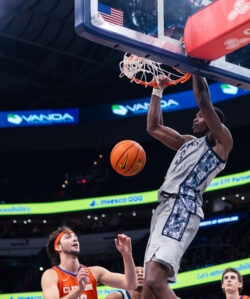If there’s an epicenter of equine activity in the United States, it’s probably not far from here.

“Maryland, Virginia, Pennsylvania—these are historically the hotspots in the United States,” trainer Jeff Becker said. “It’s probably the largest concentration of horses in the country, literally thousands of stables and every week new ones open.”
Becker runs one such stable, Lakeside, which he calls “the best office in the world.” This “office,” located on 200 acres at the base of Sugarloaf Mountain in Clarksburg, Maryland, is home to some 50 horses, a donkey named Jacob, and one of Georgetown’s newest club sports: the GU Equestrian Team.
While the team is in its first year as a recognized, funded club sport, its genesis goes back a few years to the efforts of a small group of dedicated riders.
“We’ve been pushing for this since I was a freshman,” club president Dawn Darling (NHS `09) said. “Finally the club sports department contacted us at the end of last semester and told us that the insurance had approved us, which was the hold up the whole time.”

Unfortunately, the approval came a year too late for Katie Corrigan (COL `08) and Jane Pennebaker (SFS `08), the two riders who had worked with Darling to get the club approved. But even with insurance approval, there was still much to be done. Darling had to present a budget proposal to the Club Sports Advisory Board without knowing what sort of interest the new team would garner the following year—the proposed $1,800 budget is not nearly enough to support the 19 girls that now make up the team.
This past summer, Darling, along with the club’s vice-president Allison Goodrich (COL `09) and treasurer Charlotte Dagher (MSB `10), scoured the surrounding horse country in search of a suitable barn at which the team could practice. After emailing or calling about 30 barns from a list that Corrigan had compiled over the past few years, Darling got six responses. A couple of duds later, the group came to Lakeside, where they met Jeff Becker. Becker, already the trainer of American University’s team, was the perfect fit.
“We knew we wanted Jeff as soon as we met with him,” Darling said. “He already had experience coaching American and he was very patient with the lack of organization that we experienced in our first few months of existence.”
The team has also found Becker’s knowledge of the Intercollegiate Horse Show Association to be invaluable for getting them registered and prepared for upcoming competitions. Members of the squad will compete in three IHSA events this semester (they missed the first because the University was late cutting a check), and another five next semester.
Dagher, Vanessa Gottlieb (SFS `09), and Gretchen Voelcker (MSB `11) attend practice at noon on Sundays—with only one instructor, and varying skill levels and schedules, the team must split up practices over the course of the week. The trip to the barn is about 40 minutes up 270-North; once there, the three head directly into the barn where Dagher checks on her two horses, Malcolm and Freddy, and Gottlieb and Voelcker await their assignments from Becker. This past Sunday, Dagher rode Roddick, Gottlieb got Prince, and Voelcker was paired with the “freaking awesome” Wiley.
Almost a third of the riders’ time at the barn is dedicated to grooming and “tacking”—dressing and saddling—the horses, the first part of a relationship that is, according to Becker, of paramount importance.
“The number one thing I stress when I’m working with people is their partnership with the horse,” he said. “You want the horse and the rider to be one unit, and that starts before you ever leave the barn.”
Once saddled, the riders lead their horses to a large outdoor arena where they mount and begin a series of warm-up exercises around Becker. The warm-up includes various “serpentines” and “figure eights” with the horses, as well as transitions from walking to trotting and cantering. At one point, the girls are asked to ride without use of their saddles, a painful looking leg exercise that no one seems to enjoy. All the while, Becker offers corrections and advice on form and technique.
“We show in equitation, which is when the horse and rider are judged, but more the rider than the horse,” he said. “The criteria of the judges in competition is typically hands, seat, leg, and guidance of the mount.”
Next it’s on to the adjacent five acre jumping field. Here, the riders take turns guiding their horses over a progression of jumps. When Dagher’s horse clips a beam and knocks it off the jump, Becker quickly points out that in this case, it was the horse’s fault, not the rider’s. He explains that, in IHSA competition, the judges are supposed to focus solely on the rider and not on their mount. This is because riders do not get to choose their horse at IHSA shows, but are provided with one by the host university, and don’t even get to warm-up with it before competing.
While the girls unsaddled their horses after the training session, Becker was eager to educate an ignorant sports writer on the ins and outs of the sport of horse riding.
“Fitness is definitely a factor,” he said, his own muscular physique supporting the claim. “Your leg muscles, your inner thighs, your groin, and calves, but also your back—all of it is utilized when you are on top of a horse.”
Becker played soccer and baseball growing up, but when asked how horse riding compared to other sports, he was quick to defend his one true love.
“People tend to believe the horse does all the work,” he said. “If you believe that you should really come out and try it yourself.”




